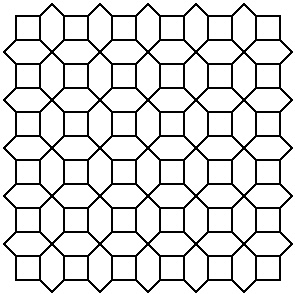Neutral Mutator (part III)
Another game that fits nicely with this mutator is Y. The complexity of this game on even quite small boards is amazing:
abcdefghi --x---?----o---?--
5 ? e1 f4 e4 h2
4 x ? c1 c3 f2 e5
3 x o ? g1 d4 a1 i1
2 x . o o b2 g3 h2i1 a1
1 ? x x ? o c3d4 g1 resigns
'o' must swap (as there is only one empty cell), and though momentarily creating a winning path, must immediately destroy it by exchanging one of his vital stones. But in doing that, 'o' provides a winning path for 'x'.
Neu-Reversi can be played in two ways.
(a) NeuVersi: a neutral stone can be dropped anywhere on the board;
(b) AdNeuVersi: it must be adjacent to some stone(s) of some player(s).
In both games, the playing of a genuine stone must follow reversi rules, and neutral stones can be turned over to the player's colour as if they were opponent stones; and if two neutrals are flipped, both must be legal reversi moves in the order played. As always, if a player cannot make a legal move he is obliged to pass, and if both are thus obliged to pass the game ends and the count is done. Note, there is no need for the extra game-end placement default-option rules in these games.
The discoverers have tried both versions, and found them both to have their own intriguing characters, which are noticeably (though not overwhelmingly) different from the parent game. In general, as with all Neu-games, there tend to appear more strategic plans and tactical resources than with parent games, for the same-sized boards.
Here is an example for NeuVersi :
--x---?-----o---?--
1. e3 g7 f3 c4
2. f4 f6 b3 h8
3. c5 b4 a4 g4
4. a2 h4
. . . . . . . . 1
x . . . . . . . 2
. x . . x o . . 3
o o x x x x ? ? 4
. . x x x . . . 5
. . . . . ? . . 6
. . . . . . ? . 7
. . . . . . . ? 8
a b c d e f g h
'x' tries to get the h8 corner in the next turn. However, 'o' moves 4... h4 a8, with the following result:
. . . . . . . . 1
x . . . . . . . 2
. x . . x o . . 3
o o o o o o o o 4
. . x x x . . . 5
. . . . . ? . . 6
. . . . . . ? . 7
? . . . . . . ? 8
a b c d e f g h
if 'x' swaps h8, there will be only one neutral left (a8) which provides no captures. So, the move is illegal and 'x' cannot take the corner. [cont.]
